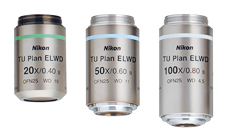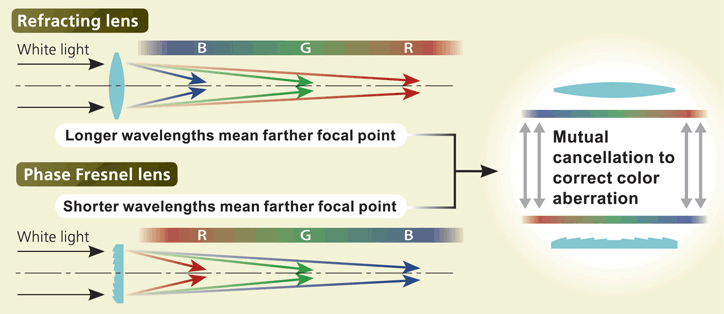Nikon Introduces CFI60-2 Objective Series for Industrial Microscopes
Employing phase Fresnel lenses developed using Nikon’s own optical technologies
September 25, 2012

Nikon Corporation (Makoto Kimura, President; Tokyo) is pleased to announce the release of the CFI60-2 objective series for industrial microscopes on October 1, 2012, which further enhances the capabilities of chromatic-aberration reduction and long working distances (*1) compared with the CFI60 objective series.
- *1Working distance (WD) refers to the distance from the tip of an objective to a subject, with the subject in focus. Long working distances offer various advantages such as preventing an objective from coming in contact with the subject when the objective is switched.
Product Information
Product name: Nikon CFI60-2 objective series for industrial microscopes
Objectives employing phase Fresnel lenses (*2)
- TU Plan EPI/BD ELWD Long working distance objective (bright-field type, bright/dark-field type)
- T Plan EPI SLWD super long working distance objective (bright-field type)
- TU Plan Apo EPI/BD Plan apochromat objective (bright-field type, bright/dark-field type)
Standard-type objectives
- TU Plan Fluor EPI/BD (bright-field type, bright/dark-field type)
- T Plan EPI ultra-low magnification objective (bright-field type)
- TU Plan Fluor EPI P polarization objective (for polarization)
Availability: From October 1, 2012 (sequential sales start)
Background of Development
Industrial microscopes have been utilized for applications such as observation, examination, research, and analysis in a wide variety of fields including semiconductors, flat panel displays, electronic components, and various materials.
In these fields, a diverse range of samples is observed using various microscopic methods where both high optical performance and ease of operation are demanded.
To meet these demands, Nikon has developed the CFI60-2 objective series, which employs phase Fresnel lenses developed using Nikon’s own optical technologies to further improve the ease of operation attributed to the optical performance and long working distances, which are highly valued in the existing CFI60 objective series.
Key Features
[CFI60-2 objective series for industrial microscopes]
1. 1. Employing Nikon’s original phase Fresnel lenses(*2)
Phase Fresnel lenses developed using Nikon’s own optical technologies are used for the objectives of industrial microscopes. This enables chromatic aberration, which reduces contrast, to be accurately corrected at individual classes, resulting in sharper, clearer images. In addition, the lengthened working distances improve operability.
- TU Plan ELWD series Long working distance objective
(Working distance: for 20X, 1.5 times longer than existing products) - T Plan SLWD series Super long working distance objective
(Working distance: for 100X, 1.5 times longer than existing products) - TU Plan Apo series Plan apochromat objective
(Working distance: for 100X, 5 times longer than existing products, or 2 mm; for 150X, 1.5 mm)
2. Improved basic performance of the standard-type objective series
For the standard-type TU Plan Fluor series objective (for bright-field, dark-field, differential interference, polarization, fluorescence), the performance of chromatic aberration for the middle range magnification (10X and 20X) has been improved, and the basic performance of the entire series has been increased. This makes it possible to obtain sharper, clearer images while maintaining the high NA and long working distances of the existing series.
3. Reduced weight
The weight of the 50X, 100X, and 150X high magnification objectives has been reduced by approximately 30% compared with existing products.
This has narrowed the weight differences with objectives of other magnification levels, reducing inconveniences in replacing the objectives.
4. Improved contrast by ultra-low magnification objectives
The T Plan EPI 1X and 2.5X objectives for ultra-low magnification and wide-field macro observation incorporate circularly polarizing plates and a depolarizer to suppress flare, which is induced when observing low reflectivity samples and which is specific to ultra-low magnification objectives, enabling sharper, clearer images to be observed. This makes it possible to eliminate existing potential problems that reduce contrast when an objective is attached to an OEM use microscope.
-
*2Phase Fresnel lens
This is a type of diffractive optical element.
Typically, a lens forms an image on, for example, a viewing plane or imaging plane, using the photorefractive phenomenon. The degree of light refraction differs depending on the color (wavelength), and image formation is performed in the order of blue (B), green (G), then red (R) starting with the portion near the lens. The color deviation referred to as chromatic aberration induces color bleeding, resulting in a deterioration of observed or captured images.
To prevent this chromatic aberration, various methods are used such as combining a convex lens and concave lens or using lens glass materials with small chromatic aberration.The phase Fresnel lenses developed by Nikon, on the other hand, uses the photo diffraction phenomenon.
Unlike the conventional refractive phenomenon, image formation is performed in the order of red (R), green (G), then blue (B) starting with the portion near the lens. Combining a phase Fresnel lens like this with a conventional refractive lens makes it possible to offset color deviation and intensively compensate for chromatic aberration.Diffraction phenomenon: Light has characteristics as a waveform. When a waveform faces an obstacle, it attempts to go around and behind it, and this characteristic is referred to as diffraction.
Diffraction causes chromatic dispersion in the reverse order of refraction.

<Main Specifications of the CFI60-2 Objectives>
Swipe horizontally to view full table.
| Application | Name (Type) |
Magnification | Numerical Aperture (NA) |
Working Distance (WD) (mm) |
|---|---|---|---|---|
| Bright field | T Plan EPI Plan (Semi-apochromat) |
1X | 0.03 | 3.8 |
| 2.5X | 0.075 | 6.5 | ||
| TU Plan Fluor EPI Plan fluor (Semi-apochromat) |
5X | 0.15 | 23.5 | |
| 10X | 0.30 | 17.5 | ||
| 20X | 0.45 | 4.5 | ||
| 50X | 0.8 | 1.0 | ||
| 100X | 0.9 | 1.0 | ||
| TU Plan Apo EPI Plan apo (Apochromat) [Phase Fresnel lens type] |
50X | 0.8 | 2.0 | |
| 100X | 0.9 | 2.0 | ||
| 150X | 0.9 | 1.5 | ||
| Polarization | TU Plan Fluor EPI P Plan fluor for polarization (Semi-apochromat) |
5X | 0.15 | 23.5 |
| 10X | 0.30 | 17.5 | ||
| 20X | 0.45 | 4.5 | ||
| 50X | 0.8 | 1.0 | ||
| 100X | 0.9 | 1.0 | ||
| Bright-field long working distance |
TU Plan EPI ELWD Long working distance plan (Semi-apochromat) [Phase Fresnel lens type] |
20X | 0.4 | 19.0 |
| 50X | 0.6 | 11.0 | ||
| 100X | 0.8 | 4.5 | ||
| Bright-field super long working distance |
T Plan EPI SLWD Super long working distance plan (Semi-apochromat) [Phase Fresnel lens type] |
10X | 0.2 | 37.0 |
| 20X | 0.3 | 30.0 | ||
| 50X | 0.4 | 22.0 | ||
| 100X | 0.6 | 10.0 | ||
| Bright/dark field | TU Plan Fluor BD Plan fluor (Semi-apochromat) |
5X | 0.15 | 18.0 |
| 10X | 0.3 | 15.0 | ||
| 20X | 0.45 | 4.5 | ||
| 50X | 0.8 | 1.0 | ||
| 100X | 0.9 | 1.0 | ||
| TU Plan Apo BD Plan apo (Apochromat) [Phase Fresnel lens type] |
50X | 0.8 | 2.0 | |
| 100X | 0.9 | 2.0 | ||
| 150X | 0.9 | 1.5 | ||
| Bright/dark-field long working distance |
TU Plan BD ELWD
Long working distance plan
(Semi-apochromat)
[Phase Fresnel lens type] |
20X | 0.4 | 19.0 |
| 50X | 0.6 | 11.0 | ||
| 100X | 0.8 | 4.5 |
- *
 : Indicates a phase Fresnel lens type (diffractive optical element).
: Indicates a phase Fresnel lens type (diffractive optical element). - *The T Plan EPI 1X/2.5X objectives incorporate circularly polarizing plates and a depolarizer. (The circularly polarizing plates are removable.)
The information is current as of the date of publication. It is subject to change without notice.
